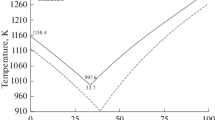Abstract
The BET method, according to which a molten salt hydrate is considered as if the water is “adsorbed” on “sites” of the salt, was used to model the liquidus temperatures of binary mixtures of common-ion salt hydrates. The method requires as input the BET parameters r, the number of sites and ε, the energy of adsorption in excess of that of the condensation of water vapor, as derived in the preceding paper. Further needed input information is the melting temperature of the salt that crystallizes out and its latent heat of melting. It is possible to model the liquidus temperature of the branch of the phase diagram between the pure salt that crystallizes out and the (first) eutectic encountered in the system with this input. The method was applied successfully to binary salt hydrate systems involving magnesium nitrate with magnesium acetate and with aluminum or nickel nitrates, magnesium and nickel chlorides, and calcium chloride with its bromide and nitrate, and with magnesium nitrate.
Similar content being viewed by others
References
M. V. Mokhosoev and T. T. Got’manova, Russ. J. Inorg. Chem. 11, 466 (1966).
H. Kimura and J. Kai, Energy Conv. Mgmt. 28, 197 (1988).
Y. Marcus, V. Dangor, and S. Lessery, Thermochim. Acta 77, 216 (1984).
Y. Marcus, A. Minevich, and L. Ben-Dor, Thermochim. Acta 412, 163 (2004).
Y. Marcus, A. Minevich, and L. Ben-Dor, J. Therm. Anal. Calorim, (2005), in press.
Y. Marcus, A. Minevich, and L. Ben-Dor, Thermochim. Acta, (2005), revision submitted.
Y. Marcus, J. Solution Chem. 34, 265 (2005).
M. R. Ally and J. Braunstein, Fluid Phase Equilib. 87, 213 (1993); M. R. Ally, and J. Braunstein, J. Chem. Thermodyn. 30, 49 (1998).
W. Voigt, Monatsh. Chem. 124, 839 (1993).
D. Zeng, Ph.D. Thesis, Technical University Freiberg, 2003.
Y. Marcus, A. Minevich, and L. Ben-Dor, J. Chem. Thermodyn. 35, 1009 (2003).
J. Guion, D. D. Sauzade, and M. Laügt, Thermochim. Acta 67, 167 (1983).
K. K. Meisingset and F. Gronwald, J. Chem. Thermodyn. 16, 523 (1984).
M. Gaune-Escard, J.-C. Mathieu, P. Desrè, and Y. Doucet, J. Chim. Phys. 1390, 1397 (1972); 1666 (1973).
M. Blander and J. Braunstein, Ann. N. Y. Acad. Sci. 1960, 838.
M. Saboungi, C. Vallet, and Y. Doucet, J. Phys. Chem. 77, 1699 (1973).
J. E. Ricci, in Molten Salt Chemistry, M. Blander, ed. (Wiley/Interscience, New York, 1964), p. 255.
Author information
Authors and Affiliations
Corresponding author
Rights and permissions
About this article
Cite this article
Marcus, Y. BET Modeling of Solid–Liquid Phase Diagrams of Common-Ion Binary Salt Hydrate Mixtures. II. Calculation of Liquidus Temperatures. J Solution Chem 34, 307–315 (2005). https://doi.org/10.1007/s10953-005-3051-2
Received:
Revised:
Issue Date:
DOI: https://doi.org/10.1007/s10953-005-3051-2




